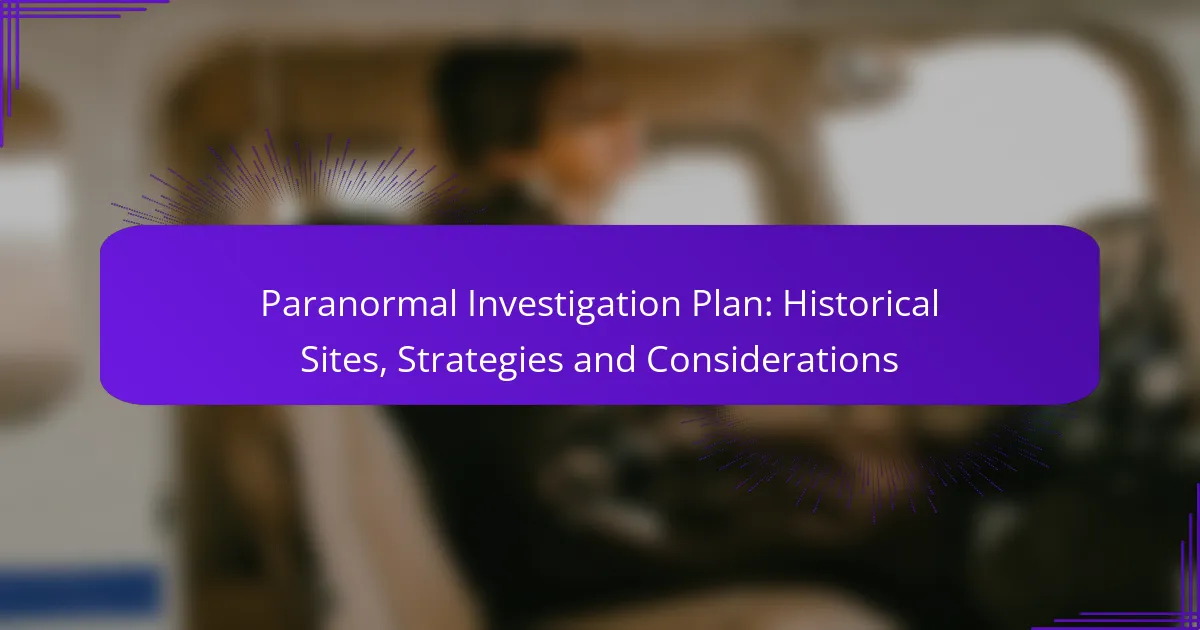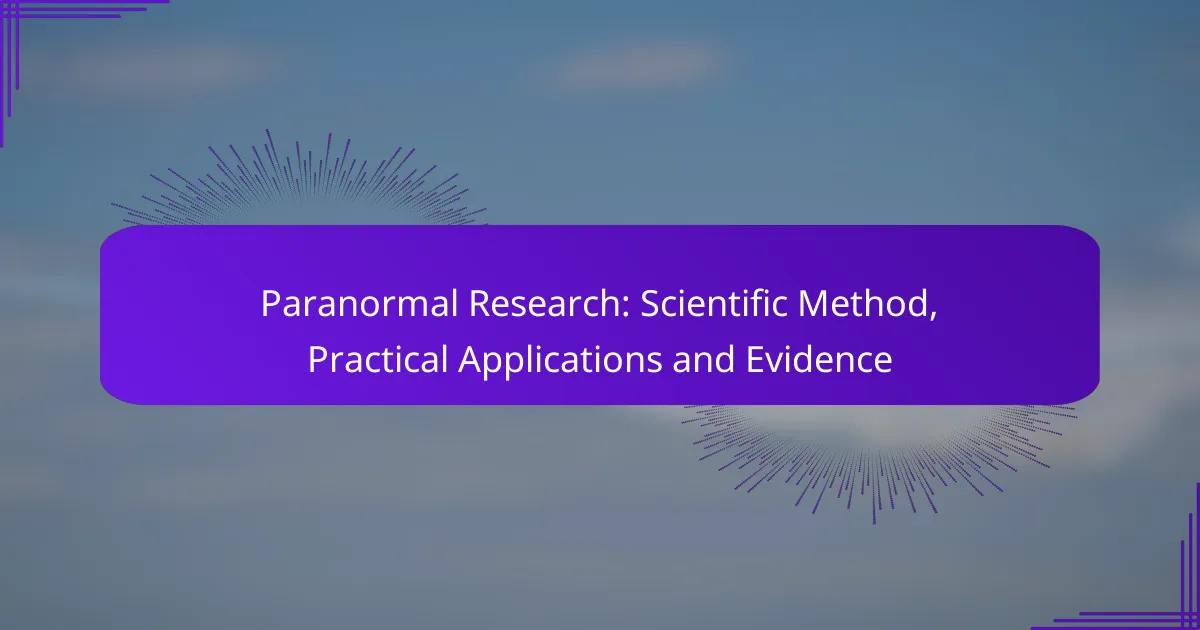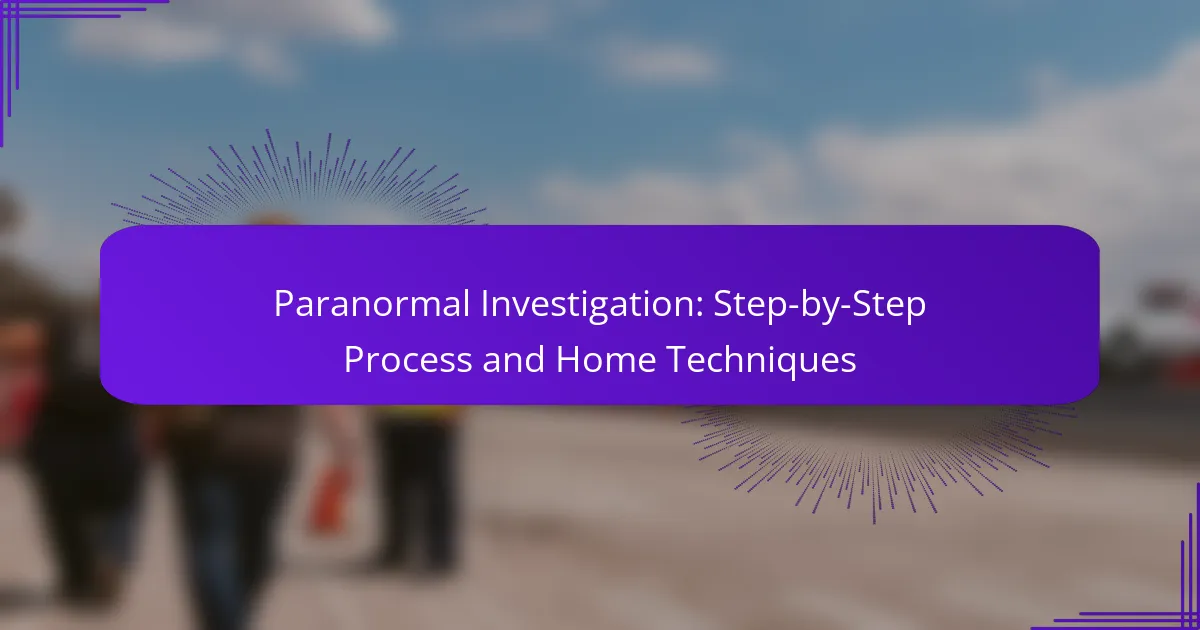Paranormal investigations at historical sites offer a unique opportunity to explore the intersection of history and the supernatural. By employing specialized equipment, conducting thorough research, and assembling dedicated teams, investigators can enhance their chances of capturing compelling evidence. However, it’s essential to navigate permissions, local laws, and safety considerations to ensure a respectful and responsible exploration of these intriguing locations.
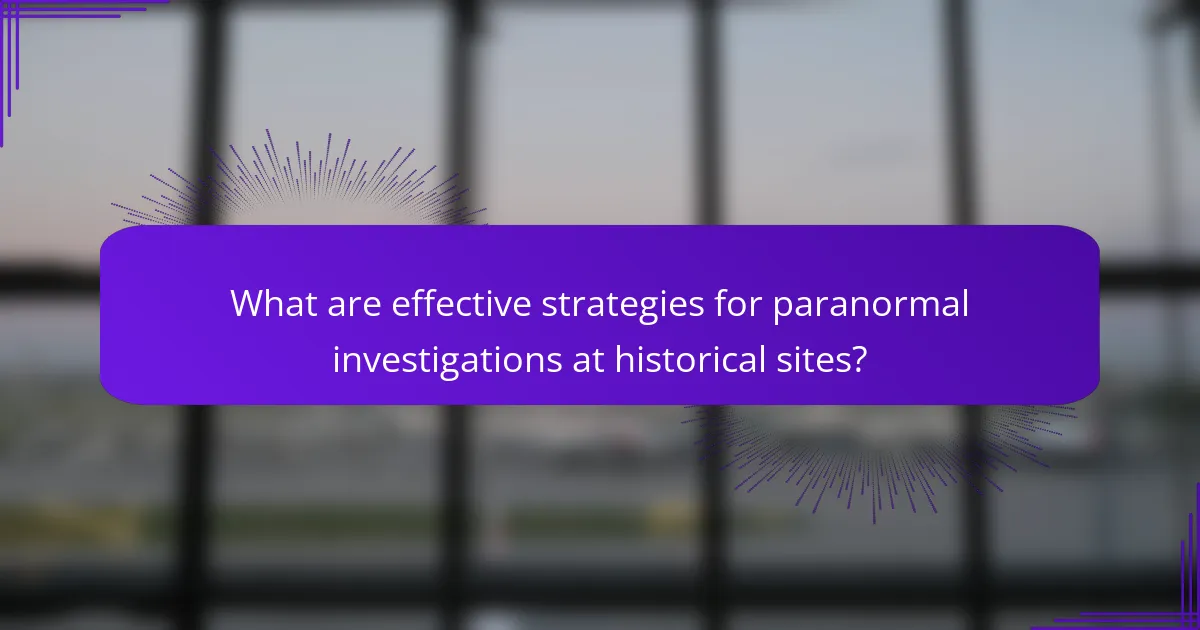
What are effective strategies for paranormal investigations at historical sites?
Effective strategies for paranormal investigations at historical sites include using specialized equipment, conducting thorough research, and forming dedicated teams. These approaches enhance the likelihood of capturing evidence and understanding the historical context of the site.
Utilizing EMF detectors
EMF detectors measure electromagnetic fields, which are often associated with paranormal activity. When investigating historical sites, use these devices to identify unusual spikes in electromagnetic readings that could indicate a presence. Aim to take readings in various locations and at different times to establish a baseline for normal activity.
Common models range from basic handheld devices to more advanced units that log data over time. Ensure your equipment is calibrated and familiarize yourself with its operation before the investigation to avoid misinterpretation of the results.
Conducting EVP sessions
Electronic Voice Phenomena (EVP) sessions involve recording audio in hopes of capturing voices or sounds that are not audible to the human ear. To conduct an effective EVP session, choose a quiet area of the historical site and ask clear, direct questions, allowing pauses for potential responses. Use high-quality audio recorders to enhance clarity.
After the session, review the recordings in a quiet environment, listening for any anomalies. It’s helpful to have multiple team members present to corroborate findings and reduce the chance of misinterpretation.
Implementing thermal imaging
Thermal imaging cameras detect heat signatures, making them valuable for identifying unexplained temperature variations in historical sites. These variations can indicate the presence of entities or drafts from hidden openings. When using thermal imaging, scan the area methodically and document any unusual readings.
Consider the ambient temperature and environmental factors that may affect readings, such as sunlight or air conditioning. Use thermal imaging as a complementary tool alongside other methods for a more comprehensive investigation.
Engaging in historical research
Thorough historical research is crucial for understanding the context of a site and its potential paranormal activity. Investigate the history of the location, including significant events, former occupants, and local legends. This background can guide your investigation and help formulate relevant questions during EVP sessions.
Utilize local archives, libraries, and online databases to gather information. Document your findings, as they can provide insights into patterns of activity and enhance the overall investigation experience.
Forming investigation teams
Forming a dedicated investigation team is essential for effective paranormal research at historical sites. Each member should have specific roles, such as equipment handling, research, or documentation, to ensure a well-organized approach. Teams typically consist of 3-6 members to maintain efficiency while allowing for diverse perspectives.
Establish clear communication protocols and conduct pre-investigation meetings to discuss objectives and strategies. This preparation fosters collaboration and enhances the chances of capturing meaningful evidence during the investigation.
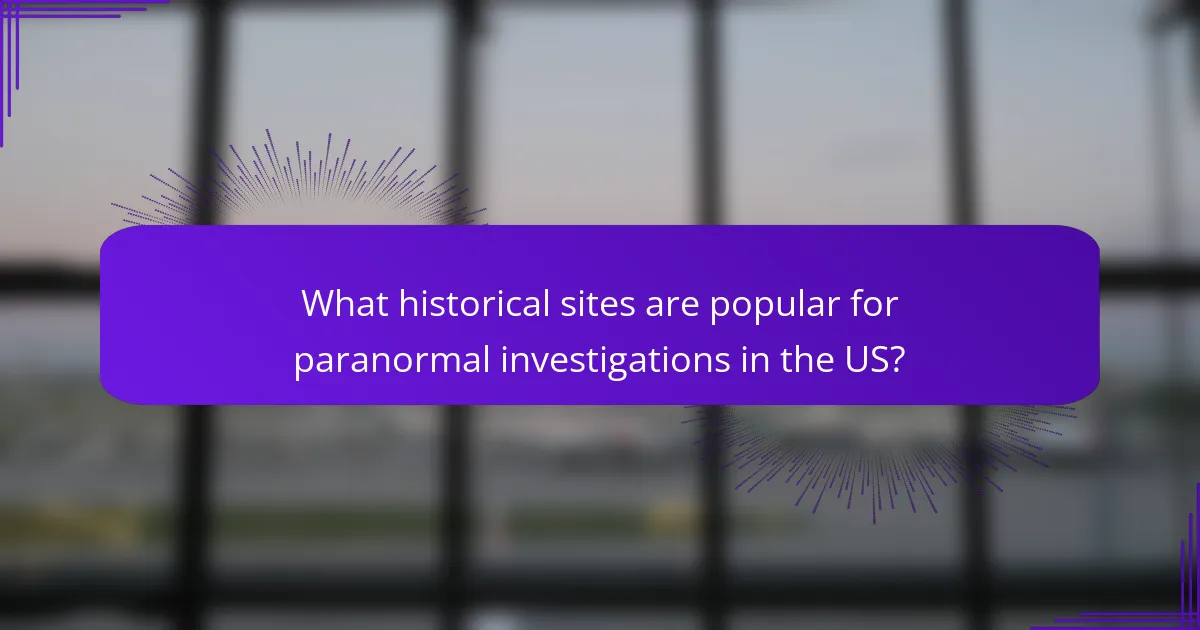
What historical sites are popular for paranormal investigations in the US?
Several historical sites in the US are renowned for their paranormal activity, attracting both amateur and professional investigators. Locations like Gettysburg Battlefield and Eastern State Penitentiary are particularly notable for their rich histories and reported ghostly encounters.
Gettysburg Battlefield
Gettysburg Battlefield is famous for its pivotal role in the Civil War and is considered one of the most haunted locations in the US. Visitors often report seeing apparitions of soldiers and hearing unexplained sounds, such as cannon fire and distant gunshots.
When investigating here, consider visiting during the evening for a more atmospheric experience. Be respectful of the site, as it is a memorial to those who lost their lives. Bringing a good quality audio recorder can help capture any potential EVPs (Electronic Voice Phenomena).
Eastern State Penitentiary
Eastern State Penitentiary, located in Philadelphia, was once one of the most famous prisons in the world and is now a hotspot for paranormal investigations. Many claim to have encountered ghostly figures and strange noises within its crumbling walls.
To enhance your investigation, consider participating in guided tours that offer insights into the prison’s history and reported hauntings. Use infrared cameras and motion detectors to capture any unusual activity, as the site is known for its eerie atmosphere after dark.
Waverly Hills Sanatorium
Waverly Hills Sanatorium in Kentucky was originally built as a tuberculosis hospital and is notorious for its dark history and numerous deaths. Paranormal investigators frequently report sightings of shadowy figures and unexplained cold spots throughout the building.
For a successful investigation, plan to explore the sanatorium during a night tour, which often includes access to the most haunted areas. Bring flashlights and extra batteries, as the power can be unreliable, and consider using a spirit box to communicate with any lingering spirits.
[censured]-Allegheny Lunatic Asylum
[censured]-Allegheny Lunatic Asylum in West Virginia is known for its haunting history as a mental institution. Many visitors have reported hearing voices and experiencing sudden drops in temperature, making it a prime location for paranormal exploration.
When investigating, take advantage of the asylum’s guided tours that provide historical context and access to various wards. Use a notebook to document your experiences and findings, as this can help identify patterns or specific areas of interest during your investigation.
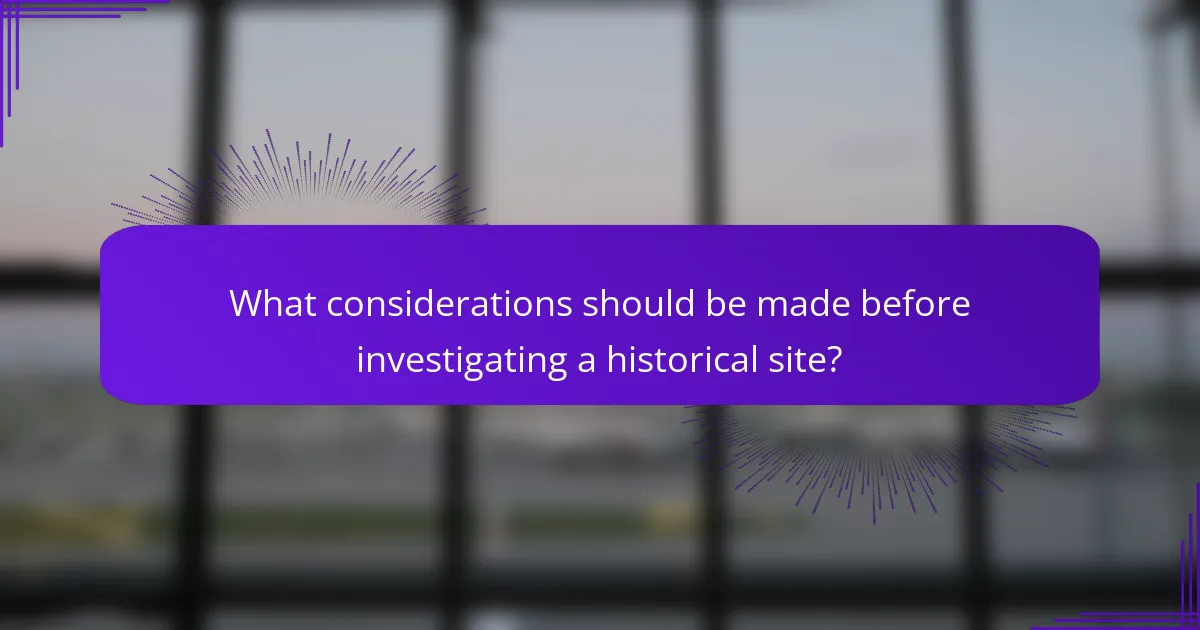
What considerations should be made before investigating a historical site?
Before investigating a historical site, it’s crucial to consider permissions, local laws, safety, and environmental conditions. These factors ensure a respectful and safe exploration while adhering to legal and ethical standards.
Obtaining necessary permissions
Securing the right permissions is essential before conducting any investigation at a historical site. This may involve contacting site owners, local authorities, or heritage organizations to obtain access and ensure compliance with regulations.
Some sites may require specific permits, especially if they are protected by law. Always check for any necessary documentation well in advance to avoid delays or legal issues.
Understanding local laws
Familiarizing yourself with local laws regarding historical sites is vital. Regulations can vary significantly by region and may dictate what activities are permissible, such as the use of equipment or the collection of samples.
In many areas, there are strict laws protecting archaeological sites and artifacts. Violating these laws can result in fines or legal action, so thorough research is necessary before proceeding.
Assessing site safety
Assessing the safety of a historical site is critical to ensure the well-being of all participants. This includes evaluating structural integrity, potential hazards, and emergency access routes.
Consider conducting a preliminary site visit to identify risks such as unstable structures, wildlife, or hazardous materials. Always have a safety plan in place, including first aid supplies and communication devices.
Preparing for environmental conditions
Environmental conditions can significantly impact your investigation. Weather, terrain, and seasonal factors should be taken into account when planning your visit.
Check forecasts and prepare for varying conditions, such as rain or extreme temperatures. Appropriate clothing, gear, and supplies can help ensure a successful and comfortable investigation.

How can one document paranormal findings effectively?
Documenting paranormal findings effectively involves using various methods to capture evidence while ensuring accuracy and detail. This includes audio recordings, field notes, photographs, and video documentation, each serving a unique purpose in the investigation process.
Using audio recording devices
Audio recording devices are essential for capturing sounds that may not be audible to the human ear during investigations. Use high-quality digital recorders with good sensitivity to ensure clarity and minimize background noise.
When using audio devices, consider the environment. Choose locations with minimal interference and avoid windy areas. Always conduct a test recording to check for clarity before starting the actual session.
Taking detailed field notes
Field notes are crucial for documenting observations and experiences during paranormal investigations. Write down the date, time, location, and any unusual occurrences, including environmental conditions and personal feelings.
Be specific in your descriptions. Instead of noting “strange sounds,” describe the sound’s nature, such as “a low humming noise” or “a series of knocks.” This level of detail will aid in analyzing findings later.
Capturing photographic evidence
Photographic evidence can provide visual documentation of paranormal activity. Use a camera with a good resolution and consider using infrared or night vision settings for low-light conditions.
When taking photos, capture multiple angles and distances of the same location. Look for anomalies such as orbs or unusual shadows, but be cautious of natural explanations like dust or reflections.
Creating video documentation
Video documentation allows for a dynamic record of paranormal investigations, capturing both visual and audio elements. Use a stable tripod and ensure the camera settings are adjusted for low-light environments.
Consider recording longer sessions to capture unexpected events. Review footage thoroughly for any unexplained phenomena, and keep a log of timestamps for significant occurrences to facilitate easier analysis later.

What are the ethical considerations in paranormal investigations?
Ethical considerations in paranormal investigations focus on respecting the history of the site and maintaining the confidentiality of participants. Investigators must approach their work with sensitivity to the cultural and emotional significance of the locations they explore.
Respecting site history
When investigating historical sites, it is crucial to acknowledge their past and the events that may have occurred there. This means conducting thorough research to understand the site’s significance and any associated narratives. Engaging with local historians or cultural experts can provide valuable insights and help avoid misrepresentation.
Additionally, investigators should avoid damaging the site or disturbing artifacts. Using non-invasive methods and obtaining necessary permissions can help protect the integrity of the location. Always prioritize the preservation of the site’s historical value over the pursuit of evidence.
Maintaining participant confidentiality
Confidentiality for participants is essential in paranormal investigations, as individuals may share personal experiences or beliefs that are sensitive in nature. Investigators should establish clear guidelines on how information will be used and ensure that participants consent to any recordings or documentation.
To maintain trust, avoid disclosing identifiable information without permission. Consider using pseudonyms or anonymizing data when sharing findings publicly. This practice not only protects individuals but also fosters a respectful and supportive environment for those involved in the investigation.
